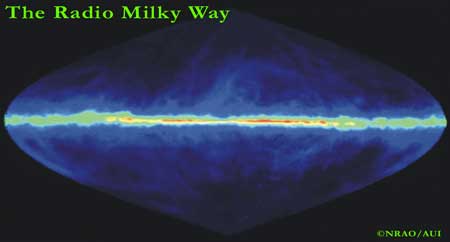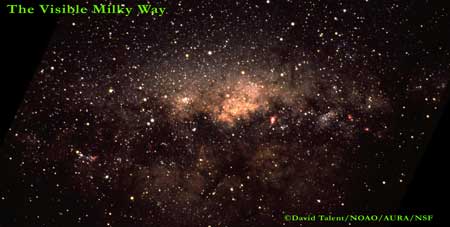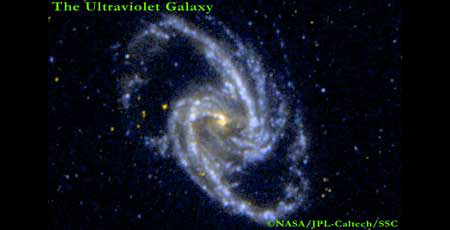
This page is a text version of Astra's Spectroscopy gallery. The old Flash galley has become the Spectroscopy App (no download is needed!) The spectroscopy app is intended to introduce visitors at Astra's Star Gate to spectroscopy in the world of science today. It contains information about stars, galaxies, the nature of light and other subjects. Here you will find longer captions, resource credits and additional details. In addition, the caption page also displays the full caption given to the images by their owners.
Topics Covered in Astra's Spectroscopy "Light Lesson" and images of the Milky Way and other galaxies at various wavelengths may be accesed by clicking below:
- Introduction - Why Light is So Fantastic!
- Light Basic - How Light Works
- Electromagnetic Spectrum - Light Radiation is continuous
The Milky Way Galaxy
- Radio Light - The Longest Wavelength
- Microwave Radiation
- Infrared Light
- Visible Light
- Ultraviolet Light
- X-Ray Radiation
- Gamma Radiation
Go to the Spectroscopy App to view the lessons this page is based on. Come back to this page to learn more!
Why Light is So Fantastic!

Click for full caption and credits of this image
Introduction
Spectroscopy has unlocked many of the secrets of the stars, galaxies and the universe. Stars make themselves known to us by the light that shines from them. While studying the stars, humans began to understand the true nature of light.
Spectroscopy is the branch of science concerned with the investigation and measurement of spectra produced when matter interacts with or emits electromagnetic radiation. I want to introduce budding astronomers to properties of light and "charts" that modern astronomers and space farers have created by viewing the Milky Way at various wavelenghts. Some day this lesson will also include views of my favorite star, our very own Sun. The first scientist who charted the stars are sometimes called astrologers, but those early pioneers probably never considered casting a horoscope. They were too busy studying the stars and how they moved in the sky. They were charting their courses in verbal and primitive terms to keep track of what was up there.
As technology developed, scientists used new tools to study the stars. With the development of glass came instruments like the telescope and the prism. These tools could teach us more about the nature of stars.
Visible Light passing through a Prism

The Prism
When visible light is passed through a prism, it breaks down into individual colors. This is because light travels through the universe in waves.
Light is bent in a prism, a property called, refraction. The rays of visible light enter one through a surface of the prism. They are bent by the surfaces where they enter and exit. Because light from the various colors travel at different wavelengths, they are separated by the refraction and are unable to blend together again when they pass out of the glass. Eventually, humans discovered that light is present in the universe at all wave lengths, from infinity large to infinitly small.
Here are some links to help you understand the principles of the prism:
Wikipedia entry on Prism Optics
Interactive Demonstration of a Prism - Interactive Physics and Math with Java
The Full Spectrum of Electromagnetic Radiation

Note: This explanation covers three slides in the gallery.
Electromagnetic Radiation
The Electromagnetic spectrum is continuous. The tiniest waves are measured in angstroms, a unit of length equal to one hundred-millionth of a centimeter. Waves of visible light are measured in nanometers (nm), while waves in infrared to radio are measured in more familiar meters.
Light waves, also called radiant energy or radiation, are measured from crest to crest. The waves are also measured by frequency, by counting the number of waves that pass a fixed point in a given period of time. (Wavelength and Frequency are dependant upon one another and share an "inverse" relationship, this is because light travels at a constant speed..) Groups or ranges of frequencies are called, "bands." Bands are identified in the image above: Gamma Rays, X-Rays, Ultraviolet, Visible, Infrared, Microwave and Radio. Waves of light have a magnetic and an electric component, a fact that was discovered by James Clerke Maxwell in 1865. For this reason, light is known by the term, "Electromagnetic Spectrum." It is also called EMR, for Electromagnetic Radiation.
As humans began to discover light outside the visible region, it was realized that Earth's atmosphere only allowed light at certain wave lengths to pass through. These became known as "windows." Eventually, we developed instruments that could be flown on balloons or on satellites orbiting above the atmosphere. Using special techniques we began opening new windows on the universe.
Links to more information on the Electromagnetic Spectrum can be found at the sites listed below:
- The Electromagetic Spectrum - from NASA Goddard Space Flight Center
- Wikipedia - Entry on the Electromagnetic Spectrum
- How light works - A basic page from How Stuff Works
- Altair- Exploring the Electromagnetic Spectrum
- The Basics of Light - from Dr. Bill Blair's Spectroscopy Page
- The Electromagetic Spectrum - Gondar Design Science
- Molecular Expressions Microscopy Primer on Light and Color - This site contains java demos of Electromagnetic Principals
Interactive EMR sites - for "Hands On" experience:
- Electromagnetic Waves- From Physics 2000
- Applet: Spectrum - See how we use energy at various frequencies
- The Electromagnetic Spectrum Tutorial - from Discovery School (a teacher's resource)
The Milky Way Galaxy at Various Wavelengths

Here is a collection of images of the Milky Way Galaxy (or what it would look like) taken in various regions of the electromagnetic spectrum. Charting the stars and other materials present in our galaxy, the various regions of the spectrum reveal new data that is cannot be collected from Earth's surface.
Many thanks to NASA, NRAO, NOAO and other organizations and individuals that make this image gallery possible.
Light at "Radio" Wavelengths

Investigators: J.M. Dickey and F.J. Lockman
Click for full caption and credits of this image
Radio Light
This image shows the Milky Way galaxy as it would appear if we could see the electromagnetic energy the hydrogen in the galaxy emits in the Radio region, specifically the 21-cm wavelength. This image is computer generated from data collected by various radio telescopes.
Radio waves are the longest waves that we have named. They are infinitely long and waves of many kilometers have been detected by Earth based telescopes. Studies of light in the radio region reveal information about interstellar gas clouds, active galaxies and galactic structure as well as radar sties of planets. Radio waves are observable from the Earth's surface because they are not blocked by the atmosphere.
Links to Radio Astronomy Observatories:
National Radio Astronomy Observatory - NRAO (U.S.)
The Mullard Radio Astronomy Observatory - Cambridge, UK
Radio Jove - NASA project for students in solar and planetary radio astronomy
Jupiter's moon Io passes through Jupiter's magnetic field, causing radio signals that can be detected using simple instruments. By studying radio emission from Jupiter, we can learn about the planet and its satellites. You might be interested in trying to detect some yourself. The sun is also an object that amateurs can study at radio wavelengths.
Microwave Radiation

Credits: NASA/WMAP Science Team
Click for full caption and credits of this image
Microwave Light
This image is part of an all-sky survey taken with the COBE satellite. The red band across the image comes from energy radiated by the Milky Way in the microwave region of the spectrum.
Studies of light in the Microwave region have been useful for studies of cosmic background radiation. Predicted by scientists who embrace the Big Bang theory for the origin of the universe, it is believed that the early universe was a very hot place and that as it expanded, the gas within it cools. Today the universe should be filled with radiation that is the heat that is left over from the Big Bang. This cosmic microwave background radiation is believed to be about 3 degrees above absolute zero. Light emitted at this temperature should be detected in the microwave region.
Websites for More Information on the Cosmic Microwave Background
Cosmic Microwave Background - Information from NASA's WMAP website
Light at Infrared Wavelengths

Credits: E. L. Wright (UCLA), The COBE Project, DIRBE, NASA
Click for full caption and credits of this image
Infrared Light
This image is part of an all-sky survey taken with the COBE satellite using the DIRBE instrument. The reddish light across the center of the image comes from energy radiated by the Milky Way in the infrared region of the spectrum.
Infrared light studes have been used to study insterstellar dust and star forming areas as well as cool stars. Infrared light has been used to study asteroids as well.
Web Sites on Infrared Astronomy:
Cool Cosmos - Spitzer Space Telescope Site
Visible Light as Seen by Humans

Website: Web Address to Access Image - National Optical Astronomy Observatory NOAO)
Click for full caption and credits of this image
Visible Light
Here is the Milky Way in visible light, somewhat like what you might see at a dark site, except that a camera collects light longer than your eye is able to gather it. This is the center of our galaxy, rather than the entire length of it, as are the other images.
Visible light has been used to study planets, stars, galaxies and other structures in the universe.
Other Links to Interesting Sites on Visible Light:
Virtual Milky Way - Panorama in Visible Light - by Axel Mellinger, a "must see" for amateur astronomers, star gazers everywhere. Find your favorite constellation in the panorama of the Milky Way in visible light.
Light in the Ultraviolet region of the Electromagnetic Spectrum

Click for full caption and credits of this image
Ultraviolet Light
This ultraviolet image of a galaxy called NGC 1365, is similar to how we currently believe our galaxy, the Milky Way, appears from the outside. It is a barred spiral type because of the bar-like quality of its central structure.
Ultraviolet light has been studied to reveal newly forming stars, stellar atmospheres and the interstellar medium. Ultraviolet light that is near the visible end of the spectrum can travel through the atmosphere, although our eyes are not keen enough to detect its presence. The Hubble Space Telescope also works in this region of the spectrum. Standard telescopes can be used to detect this ultraviolet radiation and it will also be recorded by earth bound instruments and photographic equipment. This ultraviolet radiation can also be detected by your skin, it will burn you if you spend too much time in the sun!
Links to Ultraviolet Observatories, Astronomy, Information, etc.
Astro-Observatory - A Shuttle-based instrument (Links to Ultraviolet Observatories)
FUSE - Far Ultraviolet Spectroscopic Explorer
EIT - An Ultraviolet Telescope - Studying the Sun in Ultraviolet
Galaxy Evolution Explorer - Ultraviolet Astronomy
Ultraviolet Waves - use this link to check out other information on EMR !
X-Ray Light Waves are Highly Energetic

Website: X-Ray Mosaic Of Galactic Center - from the Chandra X-Ray Observatory
Click for full caption and credits of this image
X-Ray Radiation
The image of the galactic center of the Milky Way is made of many images taken with the Chandra X-Ray Observatory. It covers an area smaller than the previous visible light image. The central white patch is believed to be a black hole at the center of our galaxy.
Studies in x-rays light have been useful on the sun and other stellar atmospheres. It has been used to study neutron stars and black holes as well as clusters of galaxies and the active nuclei of other galaxies. Only extremely hot objects or particles that are moving at very high velocities create high-energy radiation like X-rays and gamma-rays.
Links to X-Ray Astronomy:
X-Ray Astronomy - Super Novae studies from Imagine the Universe!
X-Ray Astronomy - Information from Cambridge
X-Ray Astronomy - from Wikipedia
Radiation at Gamma Frequencies

Website: The Universe at 100 MeV - NASA
Click for full caption and credits of this image
Gamma Rays
This image of the Milky Way galaxy is taken in the gamma ray region of the spectrum by Compton Gamma Ray Observatory. Gamma Waves are very energetic and are often detected in the form of gamma ray bursters. (GRBs)
Gamma rays are tiny, vibrating at a very high frequency and generally indicate a tremendous amount of energy being released. The smallest known Gamma rays are also called, "Cosmic Rays." These rays can originate in the heart of very large stars. They travel to and past the Earth from all directions and can be dangerous to humans who are not protected by the Earth's atmosphere. They make space a dangerous place for unprotected astronauts. Gamma ray studies have revealed new information about neutron stars, cosmic ray collision, active galatic nuclei and Gamma Ray Bursts (GRBs).
A few web sites on Gamma Ray Astronomy
Gamma-Ray Astronomy Team Home Page - from NASA Marshall Space Center
Steve's Gamma Ray Burst Astronomy Page
Cosmic Rays - Cosmicopia from NASA
Return to the Spectroscopy App
This page was last updated 03/23/2023
